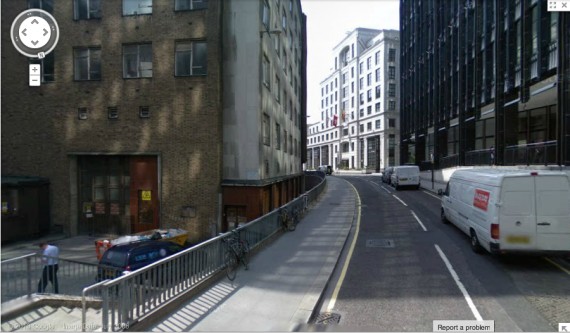The Glories of Limeburner Lane!
9. 7. 2013 // Stewart Home // Kategorie Randnotizen 2013
At the bottom of Ludgate Hill, on the north side, is Limeburner Lane. As the street stands today it dates from the 1990s. It is located on what was once part of Seacoal Lane and has an EC4 postcode. The west side of the street is largely taken up with office space – with signage to restaurants that are just out of view from the street. Santander House has its main entrance on the west side of Limeburner Lane but uses the street address 100 Ludgate Hill. Corporate banks are, of course, something one would expect to find in the square mile! On the other side of the street is a building site that will eventually house One and Two New Ludgate – construction starts next month and is scheduled to reach completion in 2015:
“The proposed development will replace two outdated properties from the 1960s, both located close to St Paul’s, with high quality office and retail accommodation as well as significant improvements to the local public realm. A new east west pedestrian route will be created across the site linking through to an open space onto Old Bailey. The new piazzetta, graced by a large tree and surrounded by cafes and shops, is formed by three distinct facades each of which catches the sun at different times during the day. The plans also include private roof terraces and green roofs that overlook Old Bailey, Ludgate Hill, St Paul’s Cathedral and the River Thames…”
Likewise, at 9 Limeburner Lane there is Seacoal House which is home to the Limeburner Lane power substation. The sixteenth-century English antiquarian John Stow believed Seacoal Lane had once been called Limeburner Lane. Contemporary academic historians say he is wrong because both streets are listed separately in earlier historical records. What is now Limeburner Lane once housed The Bell Savage Inn where plays were performed, and which is mentioned in some famous literary works. Presumably those who recently revived the name Limeburner Lane thought it sounded like a quaint survival from medieval times, but the reality is rather different!
In medieval and early modern London, limeburners heated chalk in a kiln to make quicklime. Much of this quicklime was slaked in water so that it could be used as building mortar. The job was extremely dirty and dangerous. The dust generated in the process could cause blindness, and there was always the risk the materials would spontaneously combust. The process also produced carbon monoxide – which could make limeburners dizzy or even result in black outs, with the result that some fell into the kilns that were used to produce quicklime. The life expectancy of a limeburner was not high!
Above: Limeburner Lane as you’ll never see it again – on the left a building at what used to be 100 Limeburner Street. It has been demolished to make way for the New Ludgate development.


